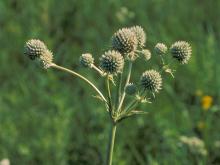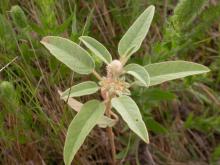Wildflowers, Grasses and Other Nonwoody Plants
Media

Species Types
Scientific Name
Ageratina altissima (formerly Eupatorium rugosum)
Description
White snakeroot looks very similar to thoroughworts, but it has triangular leaf blades that are more broadly angled or rounded at the base. White snakeroot is common statewide. It’s a toxic plant if eaten, so it’s good to be able to identify it.
Media

Species Types
Scientific Name
Polygonatum biflorum
Description
Solomon's seal grows statewide in moist, rich earth. The greenish-white flowers dangle like little bells beneath the leaves, under the gracefully arching stems.
Media

Species Types
Scientific Name
Eryngium yuccifolium
Description
“It’s an odd plant,” this rattlesnake master, “with its leaves like yucca, a head like a thistle, and second cousin to the carrot.” That’s how the great prairie writer John Madson summed it up!
Media

Species Types
Scientific Name
Asclepias meadii
Description
Mead's milkweed, an endangered wildflower, once flourished in the tallgrass prairies of the midwestern United States, including most of Missouri.
Media

Species Types
Scientific Name
Asclepias verticillata
Description
Whorled milkweed has rounded clusters of small white flowers. The leaves are soft, threadlike, and grow in whorls from the stem. It occurs in upland prairies and fields.
Media

Species Types
Scientific Name
Asclepias hirtella
Description
Prairie milkweed’s full, rounded clusters of small, delicately purple-tinged flowers set it apart from other prairie milkweeds.
Media

Species Types
Scientific Name
Croton capitatus
Description
Hogwort is fuzzy, densely covered with whitish hairs. A common but often overlooked plant in pastures, prairies, ditches, and roadsides, it’s usually less than 18 inches tall.
Media

Species Types
Scientific Name
Cuscuta spp.
Description
Dodders are easy to identify, even though at first you might not recognize them as plants. These parasitic plants usually look like a hairlike mass of yellow or orange, leafless, wiry, vining stems wrapping around the stems of other plants.
Media

Species Types
Scientific Name
Subfamily Asclepiadoideae
Description
Milkweeds are a group of plants that used to have their very own family. Now part of the dogbane family, they’re still a pretty distinctive group.
See Also
About Wildflowers, Grasses and Other Nonwoody Plants in Missouri
A very simple way of thinking about the green world is to divide the vascular plants into two groups: woody and nonwoody (or herbaceous). But this is an artificial division; many plant families include some species that are woody and some that are not. The diversity of nonwoody vascular plants is staggering! Think of all the ferns, grasses, sedges, lilies, peas, sunflowers, nightshades, milkweeds, mustards, mints, and mallows — weeds and wildflowers — and many more!





















